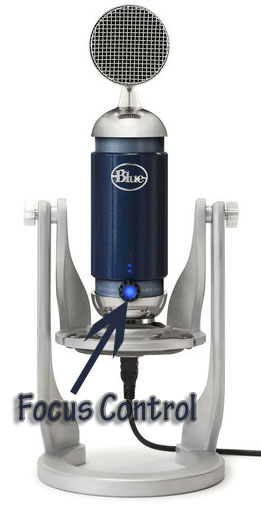 Blue, an awesome microphone company, recently [this post was written in 2013] released a condenser microphone called the Blue Spark. Very shortly thereafter, Blue released the Blue Spark Digital, which (according to Blue) is the first studio condenser microphone that you can use as both a USB mic AND an iPad mic. The Apogee MiC can do this also, but the USB mode only works with Macs!
Blue, an awesome microphone company, recently [this post was written in 2013] released a condenser microphone called the Blue Spark. Very shortly thereafter, Blue released the Blue Spark Digital, which (according to Blue) is the first studio condenser microphone that you can use as both a USB mic AND an iPad mic. The Apogee MiC can do this also, but the USB mode only works with Macs!
Anyway, both models of the Blue Spark mic come with something called “Focus Control,” which is a button that creates two different types of sound, depending on whether it is activated (pushed in) or not.
Now at first blush, this sounded to me like a simple pad switch, which is common on a lot of different condenser mics. All a pad switch does is reduce (attenuate) audio below a target frequency.
Blue describes Focus control when in the “off” position (button sticking out) as providing an “enhanced low end.” They say you can get the “big radio voice” in this mode, so voice-over folks pay heed. Then when you decide you want a “more present” sound, you push the Focus Control Button in. This provides “greater clarity and detail.”
However, Blue says this is different from standard attenuator “pad” switches because it doesn’t treat the mic’s signal output, but instead changes the input driver, essentially creating an entirely different microphone in a way. When an attenuator is applied to the output signal, as in the case of those pad switches, the quality of the signal can be degraded based on the quality of the mechanism on the mic. But by changing the input driver by “altering the voltage loading of the capsule,” you get a change in the behavior of the capsule that is more nuanced.
I very much wish I had one of these mics here (hey, I can’t buy every mic out there – sadly) [update Sep 2016 – I DID manage to get my hands on one for review. And the result is here: My Review Of The Blue Spark Digital USB And iOS Microphone. You can listen to several audio tests, including the focus control, to hear what that does.
microphones
Microphone Used By Chair Umpire At US Open Tennis Tournament

This was originally written while I was watching the 2012 US Open Tennis tournament. But I thought I’d go ahead and post it here because we’re currently watching the 2013 French Open, and I was reminded of these mics used by chair umpires. Keep an eye out for them again at the 2013 US Open [UPDATE – Yup, they made their appearance again for the 2013 US Open. though I haven’t seen them since then.]
I was going crazy trying to figure out what that large (huge really) microphone was that the chair umpires were using during the 2012 US Open Tennis Tournament. And no wonder I couldn’t find an answer – it isn’t a large mic at all! It’s a cover for the mic (any mic) called the Rycote Baby Ball Gag Windshield (yeah, sounds like something kinkier than a microphone attachment;)).
The Baby Ball Gag Windshield actually covers the capsule of a microphone to reduce the effect of wind blowing across it. The ball-shaped cover actually comes in two parts so if you need to cover a standard ball-end microphone like a Shure SM58, you can, though it is really designed for cylindrical mics like the Sennheiser MKH 416 shotgun mic.
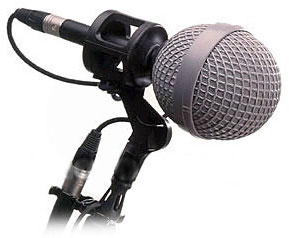
The inside of the Ball Gag is made of the same kind of materials as the full-sized modular wind shields.
Thanks goodness I finally figure this out. I must have typed “what kind of microphone is used by tennis umpires?” a hundred times before finally looking at windshield attachments rather than the mic itself. Yay! If you have been wondering like I was, here’s your answer. Also, if you need to get one of these for your own outdoor microphone needs, you can get one for yourself. Just click here.
Drum Kit Mic For Toms
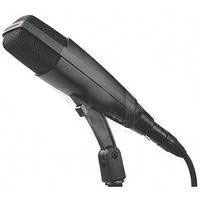
I don’t have a real drum kit – though I have always wanted one (He’s whining. Ignore him). there has always been a female in my life to stop me owning my own kit. First it was my mom. Now it is my wife. She says if we ever get a house with a basement, I can have a drum kit. Shya. Anyway…
I mostly record small drums (bodhran, dumbek, tupan, tamborine, etc.) the “real” way, meaning with an actual microphone. If I want to record a rock or pop song, I use sampled drums, typically in the form of Storm Drum (what I used on my cover of My Eyes, from Dr. Horrible, and That Thing You Do, from The Movie of the same name, which you can check out here and here, respectively), Jamstix (what I used on my cover of You’re All I Have, by Snow Patrol, which you can hear and read all about here), and Drum Experience, which I will probably use for every virtual drum kit I ever use in the future (it’s THAT awesome – check it out here.
However, if you are fortunate enough to have real drums that you can record, here is a tutorial one recording just one of them, the tom. You typically mic each drum nowadays, and there is a different mic for each. For example it’s common to use a Shure SM81 on the snare, something like a Shure Beta 52 on the kick, and as in the following video, a Sennheiser MD421.
So here is the video – another form WinkSound. Enjoy!
Golden Age Project – Entry Level Pro Audio Microphones
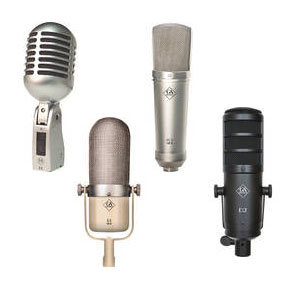 I recently discovered a company called The Golden Age Project that sells what they call entry-level microphones and other cool audio products like preamps, equalizers, compressors and accessories. From their website: We are dedicated to the idea of giving you the best price/performance ratio in the industry!
I recently discovered a company called The Golden Age Project that sells what they call entry-level microphones and other cool audio products like preamps, equalizers, compressors and accessories. From their website: We are dedicated to the idea of giving you the best price/performance ratio in the industry!
In the interest of full disclosure I have to admit that I do not own any Golden Age Project products. When I say “just discovered” above, I mean as in I just read about them 5 minutes ago. This will change, of course. I plan to acquire some of their wares as soon as may be. But until then I thought I’d share what I know so far, mainly because their philosophy of providing the best price/performance ratio is quite consistent with mine. I try to get the word out that you can enter into the world of professional audio without spending nearly as much as you think you’d have to.
So here are a few of their products:
 D2 – Large Diaphragm Dynamic Microphone (similar to the RE20 radio broadcast mic)
D2 – Large Diaphragm Dynamic Microphone (similar to the RE20 radio broadcast mic)
![]() FC 1 MK II – F.E.T Condenser Microphone
FC 1 MK II – F.E.T Condenser Microphone
![]() F4 – Multi-Pattern Small Capsule Condenser Microphone
F4 – Multi-Pattern Small Capsule Condenser Microphone
 R1 MKII Ribbon Microphone
R1 MKII Ribbon Microphone
 D1 Classic-Style Dynamic Microphone
D1 Classic-Style Dynamic Microphone
![]() PRE-73 MKII – Vintage Style Preamplifier
PRE-73 MKII – Vintage Style Preamplifier
As soon as I get an opportunity to review these items I will let everyone know with a series of new posts.
They look awesome, but of course it’s how they sound that matters.
Cheers,
Ken
Controlling Vocal Effects Right From Your Mic? The Sennheiser e 835 fx
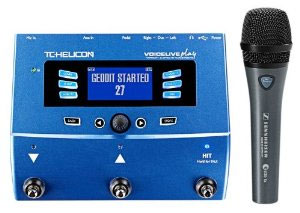 Sennhesier has partnered up with TC-Helicon to create a handheld vocal mic that lest you control vocal effects with a switch on the microphone! The mic is the Sennheiser e 835 fx, and it works with TC-Helicon’s Mic Control(tm) technology.
Sennhesier has partnered up with TC-Helicon to create a handheld vocal mic that lest you control vocal effects with a switch on the microphone! The mic is the Sennheiser e 835 fx, and it works with TC-Helicon’s Mic Control(tm) technology.
The e 835 fx (yes, those spaces are in there for some reason), is a dynamic vocal mic designed specifically to trigger a range of vocal processors (reverb, echo, looping, tuning, doubling, even harmony!) and multi-effects. It works with any and all TC-Helicon vocal effects units, of which there are many. They have eight different single-effect foot pedals, which can be chained together, as well as 10 multi-effects units.
Pictured on the left is the e 835 fx with the TC-Helicon VocalLive Play unit, which contains 200+ presets that are modeled after different music genres by adding layered vocals, background harmonies, compression, EQ ets.
Check out the below video showing a demo of the mic controlling several different effects: